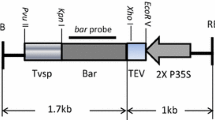Abstract
Brachypodium distachyon (Brachypodium) is a novel model plant for structural and functional genomic studies of temperate grasses. Brachypodium as a model plant has many favorable features, such as small size, small genome, short life cycle, self-fertility, and simple growth requirements. The genome sequence of the standard line Bd21 has been released and genomic resources have been developed.It is imperative to develop a method for efficient Agrobacterium-mediated Brachypodium transformation. Yellowish and compact embryogenic calli derived from immature embryos of the Bd21 were transformed with the Agrobacterium strain AGL1. Seven- and nine-week-old calli were used for transformation with Agrobacterium carrying either pCAMBIA 1301 and pCAUGH. Transformation efficiencies were assessed through histochemical GUS assay. The efficiency of transformation with pCAMBIA 1301 (based on the number of callus lines producing GUS-detected plantlets and the number of calli used for transformation) reached 20.1% (7-week-old calli) and 1.7% (9-week-old calli), and with pCAUGH (based on the number of GUS-detected plantlets and the number of regenerants) 90 and 87% for 7- and 9-week-old calli, respectively. High selection pressure was obtained by using pCAUGH, which is preferred for saving labor and time consumption during the callus selection.
Similar content being viewed by others
References
Alves SC, Worland B, Thole V, Snape JW, Bevan MW, Vain P. 2009. A protocol for Agrobacterium-mediated transformation of Brachypodium distachyon community standard line Bd21. Nat. Protoc. 4: 638–649
Bablak P, Draper J, Davey MR, Lynch PT. 1995. Plant regeneration and micropropagation of Brachypodium distachyon. Plant Cell Tiss. Org. 42: 97–107
Bennett MD, Leitch IJ. 2005. Nuclear DNA amounts in Angiosperms: Progress, problems and prospects. Ann. Botany. 95: 45–90
Bevan MW, Garvin DF, Vogel JP. 2010. Brachypodium distachyon genomics for sustainable food and fuel production. Curr. Opin. Biotech. 21: 211–217
Christiansen P, Didion T, Andersen CH, Folling M, Nielsen KK. 2005. A rapid and efficient transformation protocol for the grass Brachypodium distachyon. Plant Cell Rep. 23: 751–758
Dai S, Zheng P, Marmey P, Zhang S, Tian W, Chen S, Beachy RN, Fauquet C. 2001. Comparative analysis of transgenic rice plants obtained by Agrobacterium-mediated transformation and particle bombardment. Mol. Breed. 7: 25–33
Draper J, Mur LAJ, Jenkins G, Ghosh-Biswas GC, Bablak P, Hasterok R, Routledge APM. 2001. Brachypodium distachyon. A new model system for functional genomics in Grasses. Plant Phys. 127: 1539–1555
Duncan DR, Williams ME, Zehr BE, Widholm JM. 1985. The production of callus capable of plant regeneration from immature embryos of numerous Zea mays genotypes. Planta 165: 322–332
Feldmann KA. 1991. T-DNA insertion mutagenesis in Arabidopsis: Mutational spectrum. Plant J. 1: 71–82
Garvin DF, Gu YQ, Hasterok R, Hazen SP, Jenkins G, Mockler TC, Mur LAJ, Vogel JP. 2008. Development of genetics and genomic research resources for Brachypodium distachyon, a new model system for grass crop research. Crop Sci. 48: S69–S84
Gaut BS. 2002. Evolutionary dynamics of grass genomes. New Phytol. 154: 15–28
Goff SA. 1999. Rice as a model for cereal genomics. Curr. Opin. Plant Biol. 2: 86–89
Jefferson RA, Kavanagh TA, Bevan MW. 1987. GUS fusions: β-glucuronidase as a sensitive and versatile gene fusion marker in higher plants. EMBO J. 66: 3901–3907
Jeon WB, Lee MB, Kim DY, Hong MJ, Lee YJ, Seo YW. 2010. Efficient Phosphinothricin mediated selection of callus derived from Brachypodium mature seed. Korean J. Breed Sci. 42: 351–356
Keller B, Feuillet C. 2000. Colinearity and gene density in grass genomes. Trends Plant Sci. 5: 246–251
Kohli A, Twyman RM, Abranches R, Wegel E, Stoger E, Christou P. 2003. Transgene integration, organization and interaction in plants. Plant Mol. Biol. 52: 247–258
Opanowicz M, Vain P, Draper J, Parker D, Doonan JH. 2008. Brachypodium distachyon: Making hay with a wild grass. Trends Plant Sci. 13: 172–177
Pacurar DI, Thordal-Christensen H, Nielsen KK, Lenk I. 2008. A high-throughput Agrobacterium-mediated transformation system for the grass model species Brachypodium distachyon L. Transgenic Res. 17: 965–975
Sharma VK, Hänsch R, Mendel RR, Schulze J. 2005. Mature embryo axis-based high frequency somatic embryogenesis and plant regeneration from multiple cultivars of barley (Hordeum vulgare L.). J. Exp. Bot. 56: 1913–1922
Svitashev SK, Somers DA. 2002. Characterization of transgene loci in plants using FISH: A picture is worth a thousand words. Plant Cell Tiss. Org. 69: 205–214
Travella S, Ross SM, Harden J, Everett C, Snape JW, Harwood WA. 2005. A comparison of transgenic barley lines produced by particle bombardment and Agrobacterium-mediated techniques. Plant Cell Rep. 23: 780–789
Vogel JP, Bragg JN. 2009. Brachypodium distachyon, a new model for the triticeae. In C Feuillet, G Muehlbauer, eds, Genetics and Genomics of the Triticeae. Springer. pp 427–449. [Jorgensen RA (Series Editor): Plant Genetics and Genomics: Crops and Models, vol 7.]
Vogel JP, Garvin DF, Leong OM, Hayden DM. 2006. Agrobacterium-mediated transformation and inbred line development in the model grass Brachypodium distachyon. Plant Cell Tiss. Org. 85: 199–211
Vogel JP, Hill T. 2008. High-efficiency Agrobacterium-mediat ed transformation of Brachypodium distachyon inbred line BD21-3. Plant Cell Rep. 27: 471–478
Author information
Authors and Affiliations
Corresponding author
Rights and permissions
About this article
Cite this article
Lee, M.B., Jeon, W.B., Kim, D.Y. et al. Agrobacterium-mediated transformation of Brachypodium distachyon inbred line Bd21 with two binary vectors containing hygromycin resistance and GUS reporter genes. J. Crop Sci. Biotechnol. 14, 233–238 (2011). https://doi.org/10.1007/s12892-011-0080-9
Received:
Revised:
Accepted:
Published:
Issue Date:
DOI: https://doi.org/10.1007/s12892-011-0080-9




